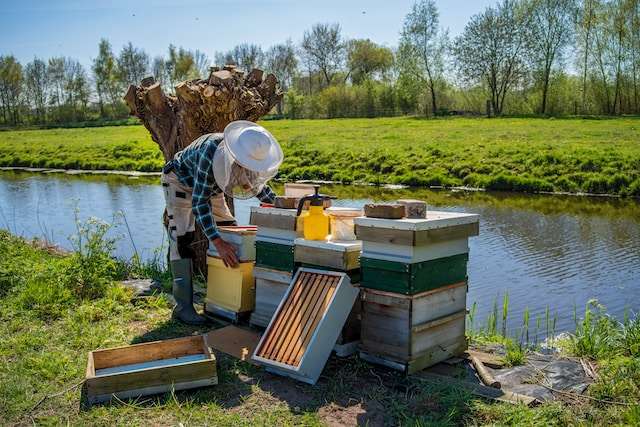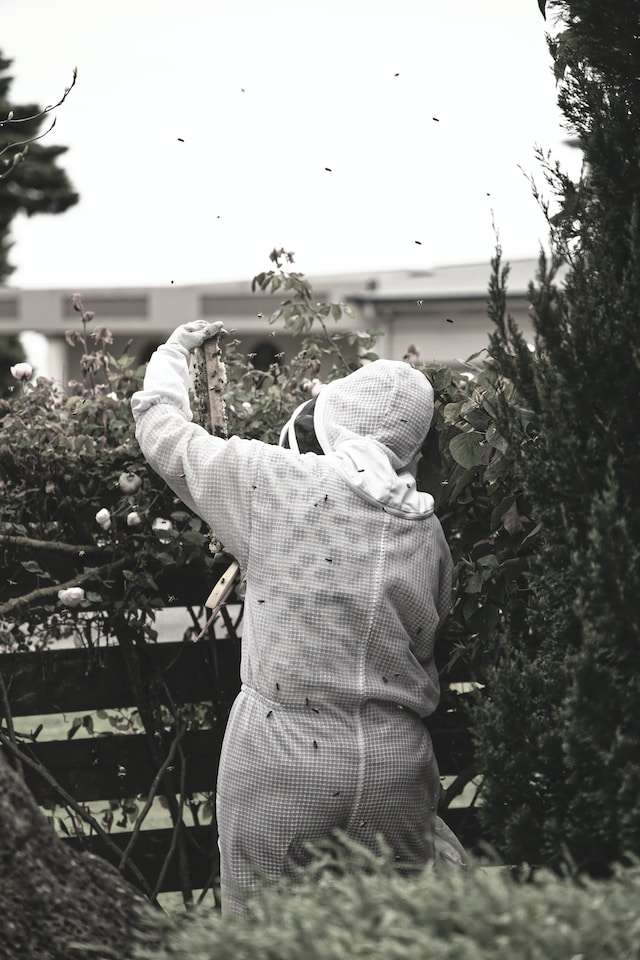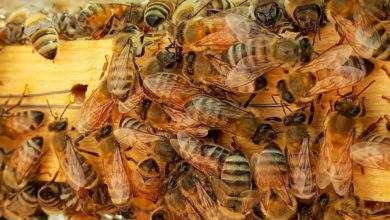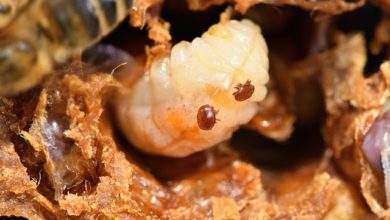Are You a Bee Whisperer?

Imagine a world buzzing with activities, foraging bees collecting nectar, pollinating flowers, and producing the golden elixir known as honey. Bees are small insects, yet their impact on our ecosystem and food production is immeasurable.
In this article, we will delve into the intriguing concept of bee whispering, exploring the art of understanding and communicating with these extraordinary creatures. Prepare to embark on a fascinating journey into the world of bees, as we discover their importance and unravel the secrets they hold.
The Concept of Bee Whispering
Bee whispering is not about mystical abilities or magical powers, but rather a deep understanding of the behavior and needs of bees. Like whispering to horses or dogs, bee whispering involves developing a unique connection with bees by using calmness, patience, and respect. By learning their language and observing their intricate communication systems, it is possible to establish a profound bond with these remarkable insects.
Importance of Understanding and Communicating with Bees
Bees play an extraordinary role in maintaining the delicate balance of our planet’s ecosystems. As pollinators, they are responsible for the reproduction of countless plant species, including many crops that form the foundation of our food systems. Without bees, the tapestry of our natural world would unravel, leading to catastrophic consequences for both the environment and humanity.
Throughout history, humans have sought to harness the incredible benefits that bees offer. From the sweet reward of honey to the healing properties of bee-derived products like propolis and royal jelly, our fascination with these creatures runs deep. However, our relationship with bees has too often been one-sided, with humans exploiting their resources without fully understanding or appreciating their needs.
By honing the art of bee whispering, we can foster a more harmonious connection between ourselves and these industrious insects. Through deepening our understanding of their complex social structures, nurturing their habitats, and providing them with the conditions they require to thrive, we can create a mutually beneficial relationship.
Becoming a Bee Whisperer
Have you ever wondered what it takes to communicate with bees? Do you wish to unlock the secrets of their complex behavior and understand their unique mindset? If so, then welcome to the fascinating world of becoming a bee whisperer. Here we will delve into the fundamental aspects of understanding bees, developing a sense of awareness and observation, and learning to interpret and respond to their communication cues. So, put on your beekeeping suit and let’s embark on this enlightening journey.
Understanding the mindset and behavior of bees
To truly become a bee whisperer, one must start by gaining a deep understanding of the mindset and behavior of these remarkable creatures. Bees are highly social insects that rely on effective communication for their survival and success as a colony. They exhibit intricate patterns of behavior that are both fascinating and essential for their functioning. Some key aspects to consider when understanding bees include:
1. The hierarchy within the hive: Bees maintain a well-structured society, with individual roles and responsibilities for each member. From the diligent workers who forage for nectar and pollen to the ever-regal queen bee, understanding the dynamics within the hive is crucial.
2. The importance of pheromones: Bees utilize chemical signals called pheromones to communicate with one another. These odorants help them convey messages about food sources, potential threats, and even regulation of the colony’s reproductive processes. Understanding the role of pheromones is vital in deciphering bee behavior.
3. The dance of the honeybee: One of the most remarkable forms of communication among bees is the waggle dance. Honeybees use this intricate dance to communicate the direction and distance of valuable foraging locations. Learning how to interpret these dances will unlock a treasure trove of information about the bee’s world.
Developing a sense of awareness and observation around bees
Becoming a skilled bee whisperer requires the development of a keen sense of awareness and observation. By sharpening your senses and being attuned to the smallest details, you can gain valuable insights into the lives of bees. Here are some tips to help you in your journey:
1. Patiently observe their flight patterns: Spend time watching bees as they fly to and from the hive. Notice how they navigate their surroundings and the specific plants they visit. Observing flight patterns can provide clues to the availability of resources and potential threats in the area.
2. Study their foraging behavior: Bees are diligent foragers, constantly seeking nectar and pollen. By observing their foraging habits, you can gain insights into the preferred flowers and the times of day when they are most active. Understanding their foraging behavior will enable you to create a thriving environment for them.
3. Take note of their body language: Bees have various behavioral cues that indicate their current state of mind. From slight vibrations or buzzing sounds to changes in wing position, their body language is a rich source of information. Learn to recognize these subtle cues to better understand their emotional and physiological states.
Learning to interpret and respond to bee communication cues
Communication lies at the heart of every successful interaction with bees. As a bee whisperer, your ability to interpret and respond to their communication cues will greatly influence your relationship with them. Here are some important cues to be aware of:
1. Pheromonal signals: Bees release specific pheromones in different situations, such as the calming “queen pheromone” or the alarm pheromone when under threat. Recognizing these signals will help you gauge the overall mood of the colony and take appropriate action.
2. Listening to the hum of the hive: The sound produced by a hive can reveal a lot about its health and well-being. The pitch and intensity of the hum can indicate factors such as colony strength, queen productivity, or even the presence of diseases. Developing a discerning ear can provide valuable insights into the hive’s condition.
3. Respecting boundaries: Bees are sentient creatures with their own comfort zones. Learning to respect their personal space and avoiding sudden movements or disturbances is crucial for maintaining a harmonious relationship. By observing their responses, you can ensure that your interactions are positive and stress-free.
Techniques and Practices of Bee Whispering
Let’s explore the techniques and practices that enable beekeepers to become bee whisperers, fostering a friendly environment, employing a careful approach, and mastering the art of bee communication.

– Creating a Friendly Environment for Bees
To truly become a bee whisperer, one must create an environment that welcomes and supports these incredible pollinators. Here are some techniques to consider:
Providing ample food sources:
- Cultivate a diverse array of flowering plants with varying bloom times.
- Incorporate plants that are native to your region and known to attract bees.
- Avoid the use of pesticides and other harmful chemicals that may harm bees.
Installing bee-friendly habitats:
- Consider setting up bee boxes or hives in suitable locations.
- Ensure the beekeeping area is sheltered from extreme weather conditions.
- Provide access to fresh water nearby, which is essential for bees’ survival.
Offering a pesticide-free environment:
- Encourage organic and sustainable practices in your garden or beekeeping area.
- Educate and raise awareness among your community about the dangers of pesticides.
- Foster a pesticide-free neighborhood or join local initiatives advocating for bee-friendly policies.
– Careful and Respectful Approach Towards Bees
Bee whispering involves a deep respect for these industrious insects, understanding their needs, and approaching them with care. Below are some practices to ensure a gentle and respectful approach:
Wearing appropriate protective clothing:
- Utilize bee suits, veils, and gloves to minimize the risk of stings.
- Ensure clothing is light-colored and smooth-textured to avoid unsettling bees.
Handling bees calmly and gently:
- Avoid sudden movements or loud noises that can agitate the bees.
- Use slow and deliberate motions when inspecting hives or tending to bees.
- Recognize that bees are more likely to sting when they feel threatened or harassed.
Engaging in regular hive inspections:
- Periodically check the health and condition of the hive to identify any issues.
- Be observant of the bees’ behavior, looking for signs of disease or distress.
- Handle frames and combs with care, minimizing disruptions to the hive’s organization.
– Mastering the Art of Bee Communication
Effective communication with bees is at the core of bee whispering. Although they don’t understand spoken language, bees communicate through body language and pheromones. Here are some key practices to consider:
Understanding bee body language:
- Learn to interpret bees’ movements, such as dancing, buzzing, and wing vibrations.
- Observe the hive entrances for signs of foraging, pollen collection, or defensive behavior.
- Develop an understanding of the different body positions and gestures bees use to communicate within the colony.
Recognizing and responding to pheromones:
- Pheromones play a vital role in bee communication and organization.
- Familiarize yourself with key pheromones, such as queen substance, alarm pheromones, and trail pheromones.
- Take note of the bees’ response to pheromones and use this information to assess their overall well-being.
Benefits of Bee Whispering
Through establishing a harmonious relationship with bees, promoting their well-being and survival, and experiencing personal fulfillment and satisfaction from connecting with nature, we can truly unlock the wonders that these incredible creatures have to offer.
- Establishing a Harmonious Relationship with Bees
Bee Whispering is a unique practice that encourages us to develop a deep understanding and connection with honeybees. By listening to and observing these extraordinary insects, we can establish a harmonious relationship based on mutual respect and trust. This allows us to work closely with bees without causing any harm or stress to them, making the endeavor both ethical and rewarding.
- Promoting the Well-being and Survival of Bee Colonies
The practice of Bee Whispering actively contributes to the well-being and survival of bee colonies.
By working in harmony with the bees, we can take necessary steps to create a conducive environment for their growth and development. This includes providing suitable habitats, ensuring access to abundant and diverse sources of nectar and pollen, and implementing sustainable beekeeping practices that prioritize their welfare.
Through Bee Whispering, we become advocates for the vital role these pollinators play in our ecosystem and actively contribute to their conservation.
- Personal Fulfillment and Satisfaction from Connecting with Nature
Engaging in Bee Whispering not only benefits the bees but also provides immense personal fulfillment and satisfaction. As we connect with nature and immerse ourselves in this awe-inspiring practice, we gain a sense of profound connection with the natural world.
The tranquility and serenity experienced while working with bees can have a remarkably calming effect on our minds and bodies, reducing stress and promoting overall well-being. Additionally, the sense of accomplishment from successfully communicating with bees and witnessing their growth and prosperity is truly rewarding.
Through Bee Whispering, we open ourselves up to a world of wonder, where we become attuned to the subtle interactions and intricate workings of nature. The benefits of establishing a harmonious relationship with bees, promoting their well-being and survival, and experiencing personal fulfillment from this connection are not limited to the individual practitioner but extend to the broader community and environment.
Tips for Aspiring Bee Whisperers
Here, we will provide aspiring bee whisperers with essential tips and insights to help them navigate the world of bees successfully. By educating oneself about bees, seeking guidance from experienced beekeepers, and practicing patience, empathy, and respect, anyone can foster a harmonious relationship with these amazing creatures.
Educating Oneself about Bees and their Habitats
To establish a deep bond with bees, it is crucial to understand their behavior, needs, and the critical role they play in our environment. Consider the following tips for self-education:
- Learn about bee species: Discover the different species of bees and their characteristics. Understanding the traits and habits of various bees will help you tailor your approach and provide the best care.
- Study hive structure and organization: Delve into the intricacies of beehives, such as the roles of bees within a colony and the construction of combs. This knowledge will lay the groundwork for effective beekeeping.
- Familiarize yourself with beekeeping equipment: Get to know the essential tools and equipment used in beekeeping, such as smokers, bee suits, and frames. Being well-equipped will ensure your safety and confidence during hive inspections.
Seeking Guidance from Experienced Beekeepers or Bee Whisperers
Learning from experienced beekeepers who have honed their craft over the years is an invaluable asset during your journey as an aspiring bee whisperer. Consider the following ways to seek guidance:
- Join beekeeping associations or clubs: Become a member of local beekeeping associations or clubs, where you can connect with experienced beekeepers, attend workshops, and gain hands-on experience.
- Attend beekeeping workshops and conferences: Participate in beekeeping workshops and conferences that provide a platform to learn from experts and exchange knowledge with fellow enthusiasts. These events can offer valuable insights and guidance for your beekeeping journey.
- Establish mentor relationships: Seek out experienced beekeepers willing to mentor and guide you. A mentor can help you navigate the challenges and uncertainties that arise when starting your beekeeping adventure.
Practicing Patience, Empathy, and Respect
Developing a harmonious relationship with bees requires patience, empathy, and respect. Utilize the following approaches to foster a positive connection with these remarkable creatures:
- Be patient and observe: Spend time watching the bees’ behavior and actions within the hive and in the surrounding environment. Patience will allow you to understand their rhythms, needs, and response to different situations.
- Approach bees calmly and gently: When interacting with bees, handle them gently and avoid sudden movements or loud noises that may agitate them. Approaching bees with a calm and respectful demeanor fosters trust between you and the colony.
- Practice ethical beekeeping: Promote sustainable beekeeping practices that prioritize the wellbeing of the colony. Minimize the use of chemicals and pesticides, provide adequate food sources, and create a secure environment for the bees to thrive.
Conclusion
Bees can be incredible allies to have in any garden, and if you wish to manage your own hive, becoming a bee whisperer is a surefire way to guarantee successful and harmonious exchanges with the hive.
In learning the basics of bee behavior and anatomy, viewers can gain an understanding of how to naturally handle and interact with bees in a safe and attitude-free manner. With the right attitude and knowledge, you can become a successful bee whisperer.

FAQs:
Can anyone become a Bee Whisperer?
- Yes, anyone with an interest in bees and the willingness to learn can become a Bee Whisperer. Regardless of age or gender, individuals who are passionate about these incredible creatures can embark on the journey of becoming a skilled beekeeper and Bee Whisperer.
Can being a Bee Whisperer help me improve my honey production?
- Absolutely! By understanding bee behavior and employing effective communication methods, you can enhance hive health, productivity, and ultimately achieve higher honey yields.
What does it mean when bees are attracted to you?
- When bees are attracted to you, it often means that you emit scents or signals that mimic the pheromones released by bees during specific activities. This could indicate that you possess qualities that make you appealing to bees, such as floral fragrances on your clothing or skin, the presence of sugary substances, or even vibrant colors resembling flowers.
How can I become a Bee Whisperer?
- Becoming a Bee Whisperer requires ample knowledge and experience about beekeeping practices, understanding their behavior, and proper hive management techniques. It is essential to receive proper training from experienced beekeepers or attend workshops and courses to acquire the necessary skills for this role.
What are the benefits of being a Bee Whisperer?
- Being a Bee Whisperer allows you to develop a profound connection and understanding of bees, which can be incredibly rewarding. By interacting with bees regularly, you contribute to their conservation while enjoying the benefits of honey production, pollination support, and fostering a harmonious relationship with nature.
How can being a Bee Whisperer positively impact the environment?
- Being a Bee Whisperer allows you to actively contribute to the conservation and survival of the vital honeybee population. By tending to bee colonies and promoting sustainable beekeeping practices, you support the essential role bees play in pollination, thereby aiding in the balance and diversity of ecosystems.
Do I need any specific equipment or gear to be a Bee Whisperer?
- Yes, being a Bee Whisperer requires certain equipment and gear to ensure your safety and effectively care for the bees. Basic items may include protective clothing such as a bee suit, gloves, and a veil. You will also need tools like a smoker, hive tools, and bee brushes to facilitate hive inspections and manipulations.
What steps should I take to ensure bees thrive under my care?
- To ensure bees thrive under your care as a Bee Whisperer, it’s crucial to prioritize their health and well-being. This involves regular hive inspections, monitoring for pests or diseases, maintaining a balanced diet for the bees through adequate forage availability, and implementing responsible hive management practices to encourage a strong and productive colony.




